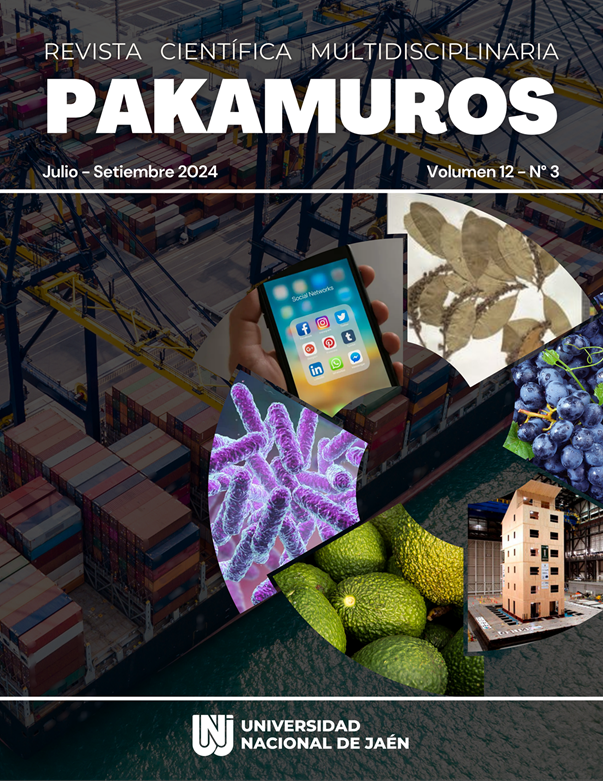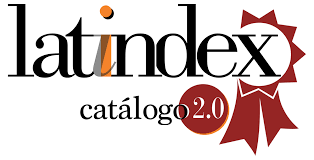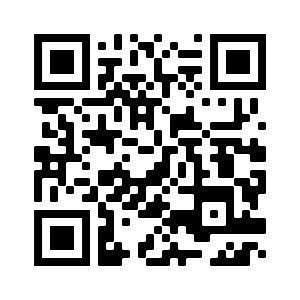Adicción a redes sociales y soledad en universitarios de la Selva Peruana
DOI:
https://doi.org/10.37787/s03fry48Palabras clave:
Adicción, móvil, redes sociales, soledad, universitariosResumen
El uso de Internet se ha vuelto esencial en la vida diaria, facilitando la educación, comunicación y el acceso a información. Las redes sociales, son utilizadas por el 60% de la población global, destacando el YouTube, Facebook, TikTok, Instagram y WhatsApp. En India, el 96.1% de los estudiantes de pregrado usa redes sociales cuando están aburridos y el 86.4% cuando se sienten solos. Por ello, el propósito de la investigación fue determinar si la adicción a redes sociales predice la soledad en universitarios de la selva peruana. Se analizaron 423 datos de estudiantes universitarios, varones y mujeres, entre 18 y 29 años (M= 21.943; DS= 2.566). La ARS se evaluó mediante la Escala Breve de Adicción a las Redes Sociales (CARS-R) y la variable soledad mediante la Escala de soledad de Jhon Gierveld. En cuanto a los resultados se evidenció que la ARS predice la soledad (R2 ajustado= 0.288, p < ,000). Es así que se concluye que un uso adictivo de las redes sociales predice sentimientos de soledad en universitarios de la selva peruana, por lo tanto, se recomienda realizar acciones que ayuden a mitigar esta adicción, pues la soledad está asociada a sentimientos de tristeza e ideación suicida.
Referencias
Aderinto, N. (2022). Impact of internet addiction on mental health among undergraduates in Nigeria. International Journal of Surgery Global Health, 1–2. https://journals.lww.com/ijsgh/fulltext/2022/11010/impact_of_internet_addiction_on_mental_health.4.aspx
Alfaro, R., Carranza, R., Mamani, O., y Caycho, T. (2022). Examining Academic Self-Efficacy and perceived social support as predictors for coping with stress in Peruvian university students. Frontiers in Education, 1–7. https://www.frontiersin.org/articles/10.3389/feduc.2022.881455/full#B21
Arillotta, D., Floresta, G., Guirguis, A., Corkery, J. M., Catalani, V., Martinotti, G., Sensi, S. L., y Schifano, F. (2023). GLP-1 Receptor Agonists and Related Mental Health Issues; Insights from a Range of Social Media Platforms Using a Mixed-Methods Approach. Brain Sciences 2023, Vol. 13, Page 1503, 13(11), 1503. https://doi.org/10.3390/BRAINSCI13111503
Arteaga, H., Quispe, N., Sánchez, K., Polin, J., Coronado, J., y Cjuno, J. (2022). Adicción a redes sociales y procrastinación académica en universitarios de la selva peruana. Revista Eugenio Espejo, 16(3), 4–12. https://www.redalyc.org/articulo.oa?id=572872037002
Ato, M., López, J., y Benavente, A. (2013). Un sistema de clasificación de los diseños de investigación en psicología. Anales de Psicología, 29(3), 1038–1059. https://scielo.isciii.es/pdf/ap/v29n3/metolologia.pdf
Azhari, A., Toms, Z., Pavlopoulou, G., Esposito, G., y Dimitriou, D. (2022). Social media use in female adolescents: Associations with anxiety, loneliness, and sleep disturbances. Acta Psychologica, 229, 1–9. https://doi.org/10.1016/j.actpsy.2022.103706
Bakry, H., Almater, A., Alslami, D., Ajaj, H., Alsowayan, R., Almutairi, A., y Almoayad, F. (2022). Social media usage and loneliness among princess Nourah University medical students. Middle East Current Psychiatry, 29, 2–8. https://doi.org/10.1186/s43045-022-00217-w
Ballesteros, H., y Pastrano, E. (2022). Nomofobia y su incidencia en el proceso de aprendizaje de los estudiantes de la unidad educativa “Replica Nicolás Infante Díaz.” Revista Maestro y Sociedad, 19(4), 1819–1838. https://maestroysociedad.uo.edu.cu/index.php/MyS/article/view/5763
Bhandarkar, A. M., Pandey, A. K., Nayak, R., Pujary, K., y Kumar, A. (2021). Impact of social media on the academic performance of undergraduate medical students. Medical Journal Armed Forces India, 77, S37–S41. https://doi.org/10.1016/J.MJAFI.2020.10.021
Cannito, L., Annunzi, E., Viganò, C., Dell’osso, B., Vismara, M., Sacco, P., Palumbo, R., y D’addario, C. (2022). The Role of Stress and cognitive absorption in predicting social network addiction. Brain Sciences, 12, 1–10. https://doi.org/10.3390/brainsci12050643
Chandrasena, P. P. C. M., y Ilankoon, I. M. P. S. (2022). The impact of social media on academic performance and interpersonal relations among health sciences undergraduates. Journal of Education and Health Promotion, 11(1), 117. https://doi.org/10.4103/JEHP.JEHP_603_21
Chávez, J., y Coaquira, C. (2022). Adicción a redes sociales y estrés académico en estudiantes ecuatorianos de nivel tecnológico. Apuntes Universitarios, 12(3), 17–37. https://apuntesuniversitarios.upeu.edu.pe/index.php/revapuntes/article/view/1101/891
Chethana, K., Nelliyanil, M., y Manjula, A. (2020). Prevalence of nomophobia and its association with loneliness, self happiness and self esteem among undergraduate medical students of a medical college in coastal Karnataka. Revista India de Investigación y Desarrollo En Salud Pública, 11(3), 523–529. https://medicopublication.com/index.php/ijphrd/article/view/1215
Chibuzor, M., y Chidozie, E. (2022). Loneliness, happiness, and interpersonal dependency as correlates of problematic use of social networking sites. Nigerian Association of Social Psychologists, 5(1), 146–168. https://www.nigerianjsp.com/index.php/NJSP/article/view/89
Ciacchini, R., Orrù, G., Cucurnia, E., Sabbatini, S., Scafuto, F., Lazzarelli, A., Miccoli, M., Gemignani, A., y Conversano, C. (2023). Social media in adolescents: A retrospective correlational study on addiction. Children, 10, 1–14. https://doi.org/https://doi.org/10.3390/
Ciudad, V., Zarco, A., Escrivá, T., Herrero, R., y Baños, R. (2024). How adolescents lose control over social networks: A process-based approach to problematic social network use. Addictive Behaviors, 154, 1–10. https://doi.org/10.1016/j.addbeh.2024.108003
Condori, L., y Coapaza, M. (2023). Redes sociales y ortografía : un estudio con universitarios (L. Condori y M. Coapaza, Eds.; Idicap Pacífico). 2023. https://idicap.com/omp/index.php/editorial/catalog/view/14/87/114
De Jong Gierveld, J., y Kamphuis, F. (1985). The Development of a Rasch-Type Loneliness Scale. Applied Psychological Measurement, 9(3), 289–299. https://conservancy.umn.edu/bitstream/handle/11299/102185/v09n3p289.pdf?sequence=1yisAllowed=y
Eichenberg, C., Schneider, R., y Rumpl, H. (2024). Social media addiction: associations with attachment style, mental distress, and personality. BMC Psychiatry, 24(1), 1–14. https://doi.org/10.1186/S12888-024-05709-Z/TABLES/6
Ferguson, C. (2009). An effect size primer: A guide for clinicians and researchers. Professional Psychology: Research and Practice, 40(5), 532–538. https://doi.org/10.1037/a0015808
Fermann, I. L., Ledur, B., Beneton, E. R., Schmitt, M., Chaves, J. G., y Andretta, I. (2021). Uso de internet y redes sociales por estudiantes universitarios: un campo de estudio emergente. Ciencias Psicológicas, 15(1), 2389. https://doi.org/10.22235/CP.V15I1.2389
Fernández, J., Casal, L., Fernández, C., y Cebreiro, B. (2020). Redes sociales y fenómenos comunicativos: Aplicación, análisis y metodologías de investigación. Revista de Ciencias Sociales, 28, 145–160. https://revistaprismasocial.es/article/view/3372/4085
García, M., Pérez, J., Fuentes, V., y Aranda, M. (2020). EDAS-18 : validación de la versión corta de la escala de dependencia y adicción al smartphone. Terapia Psicológica, 38(3), 339–361. https://scielo.conicyt.cl/pdf/terpsicol/v38n3/0718-4808-terpsicol-38-03-0339.pdf
Gokdas, I., y Kuzucu, Y. (2019). Social network addiction scale: The validity and reliability study of adolescent and adult Form. International Journal of Assessment Tools in Education, 6(3), 396–414. https://doi.org/10.21449/ijate.505863
Gómez, J., Martínez, J., Lázaro, C., y Sánchez, J. (2020). Social networks consumption and addiction in college students during the COVID-19 pandemic: Educational approach to responsible use. Sustainability, 12, 1–17. https://doi.org/10.3390/su12187737
Güner, T., y Demir, İ. (2022). Relationship between smartphone addiction and nomophobia, anxiety, self-control in high school students. Addicta: The Turkish Journal on Addictions, 9(2), 218–224. https://www.scielo.br/j/rbem/a/NLhRvmVdfm5z9MnfbLvjZFJ/?format=pdfylang=en
Hernández, J., Espinosa, J., Peñaloza, M., Rodriguez, J., Chacón, J., Toloza, C., Arenas, M., Carrillo, S., y Bermúdez, V. (2018). Sobre el uso adecuado del coeficiente de correlación de Pearson: definición, propiedades y suposiciones. Archivos Venezolanos de Farmacología y Terapéutica, 37(5), 457–595. https://www.revistaavft.com/images/revistas/2018/avft_5_2018/25sobre_uso_adecuado_coeficiente.pdf
Hilt, J. (2019). Dependencia del celular, hábitos y actitudes hacia la lectura y su relación con el rendimiento académico. Revista de Investigación Apuntes Universitarios, 9, 103–116. https://doi.org/10.17162/au.v9i3.384
Instituto Nacional de Estadística e Informática (INEI). (2023). Estadística de las tecnologías de información y comunicación en los hogares. https://m.inei.gob.pe/media/MenuRecursivo/boletines/boletin_tics_3t2023.pdf
Isbulan, O., Cam, E., y Griffiths, M. D. (2024). The mediating effect of social network identity management on the relationship between personality traits and social media addiction among pre-service teachers. BMC Psychology, 12(1), 1–11. https://doi.org/10.1186/S40359-024-01653-5/TABLES/4
Iwatani, S., y Watamura, E. (2024). Antecedents of social media addiction in high and low relational mobility societies: Motivation to expand social network and fear of reputational damage. PLOS ONE, 19(4), e0300681. https://doi.org/10.1371/JOURNAL.PONE.0300681
Kaviani, F., Robards, B., Young, K., y Koppel, S. (2020). Nomophobia: Is the fear of being without a smartphone associated with problematic use. International Journal of Environmental Research and Public Health, 17, 1–19. https://doi.org/10.3390/ijerph17176024
Khodarahmi, E., Amanelahi, A., y Abbaspour, Z. (2023). Prediction of Social Media Addiction Among Female Adolescents Based on Parent-Adolescent Conflict and Parental Psychological Control. International Journal of High Risk Behaviors and Addiction 2023 12:4, 12(4), 134279. https://doi.org/10.5812/IJHRBA-134279
Kimball, H. G., Fernandez, F., Moskowitz, K. A., Kang, M., Alexander, L. M., Conway, K. P., Merikangas, K. R., Salum, G. A., y Milham, M. P. (2023). Parent-Perceived Benefits and Harms Associated With Internet Use by Adolescent Offspring. JAMA Network Open, 6(10), e2339851–e2339851. https://doi.org/10.1001/JAMANETWORKOPEN.2023.39851
Kubrusly, M., Silva, P., Vidal, G., Goncalves, E., Santos, P., y Lima, A. (2021). Nomophobia among medical students and its association with depression, anxiety, stress and academic performance. Brasileira de Educação Médica, 45(3), 1–8. https://www.scielo.br/j/rbem/a/NLhRvmVdfm5z9MnfbLvjZFJ/?format=pdfylang=en
Landa, M., Reyes, Y., Landa, A., Cortés, A., y Paz, E. (2024). Social media addiction relationship with academic engagement in university students: The mediator role of self-esteem, depression, and anxiety. Heliyon, 10, 1–10. https://doi.org/10.1016/j.heliyon.2024.e24384
López, M., Tapia, A., y Ruiz, C. (2023). Patologías y dependencias que provocan las redes sociales en los jóvenes nativos digitales. Revista de Comunicación y Salud, 13, 1–21. https://doi.org/10.35669/rcys.2023.13.e301
MacDonald, K., & Schermer, J. (2021). Loneliness unlocked: Associations with smartphone use and personality. Acta Psychologica, 1–11. https://doi.org/10.1016/j.actpsy.2021.103454
Malander, N. (2019). Adicciones tecnológicas en adolescentes: Relación con la percepción de las prácticas parentales. Drugs and Addictive Behavior, 4(1), 25–45. https://doi.org/10.21501/24631779.2761
Metin, I., y Demirtepe, D. (2021). Cyberloafing behaviors among university students: Their relationships with positive and negative affect. Current Psychology, 0123456789. https://pubmed.ncbi.nlm.nih.gov/34690469/
Miñan, G., Flores, J., Piñas, A., Suria, Y., Toledo, W., Garcia, J., y Mejia, G. (2023). Estrés académico y adicción a las redes sociales en estudiantes universitarios peruanos. Salud, Ciencia y Tecnología, 3, 1–9. https://doi.org/10.56294/SALUDCYT2023519
Nagata, J. M., Sajjad, O. M., Smith, N., Zamora, G., Dhama, S., Al-shoaibi, A. A. A., Ganson, K. T., Testa, A., Moreno, M. A., Kiss, O., Baker, F. C., y Jackson, D. B. (2024). Social Media Use and Alcohol Sipping in Early Adolescents: A Prospective Cohort Study. Substance Use y Misuse, 59(6), 971–976. https://doi.org/10.1080/10826084.2024.2310501
Niskier, S. R., Snaychuk, L. A., Kim, H. S., da Silva, T. T., Vitalle, M. S. de S., y Tavares, H. (2024). Adolescent Screen Use: Problematic Internet Use and the Impact of Gender. Psychiatry Investigation, 21(1), 18–27. https://doi.org/10.30773/PI.2023.0178
Okela, A. H. (2023). Egyptian university students’ smartphone addiction and their digital media literacy level. Journal of Media Literacy Education, 15(1), 44–57. https://doi.org/https://doi.org/10.23860/JMLE-2023-15-1-4
Orozco, H., y Lamberto, J. (2022). La ética en la investigación científica: Consideraciones desde el área educativa. Revistas de Historia, Geograía, Arte y Cultura, 11–21. http://perspectivas.unermb.web.ve/index.php/Perspectivas/article/view/355
Özsat, K., Işıktaş, S., & Şenol, H. (2022). Investigation of the effect of social media addiction levels of university students on virtual environment loneliness levels. Journal of Educational Technology and Online Learning, 5(4), 1030–1040. https://doi.org/10.31681/jetol.1148704
Paray, M., Tanquiamco, D., Kenneth, S., Borlio, J., y Buladaco, M. (2020). A correlational study on nomophobia and physical health of Panaboans across age groups. International Journal of Research and Innovation in Social Science, IV, 256–262. https://www.rsisinternational.org/journals/ijriss/Digital-Library/volume-4-issue-6/256-262.pdf
Pérez, E., y Medrano, L. (2010). Análisis factorial exploratorio: Bases conceptuales y metodológicas. Revista Argentina de Ciencias Del Comportamiento, 2, 58–66. https://dialnet.unirioja.es/servlet/articulo?codigo=3161108
Priftis, N., y Panagiotakos, D. (2023). Screen Time and Its Health Consequences in Children and Adolescents. Children 2023, Vol. 10, Page 1665, 10(10), 1665. https://doi.org/10.3390/CHILDREN10101665
Richaud, M. (2007). La ética en la investigación psicológica. Enfoques, XIX, 5–18. https://www.redalyc.org/pdf/259/25913121002.pdf
Sabir, I., Nasim, I., Majid, M., Mahmud, M., y Sabir, N. (2020). TikTok addictions and its disorders among youth of Pakistan. Scholedge International Journal of Multidisciplinary y Allied Studies , 7(6), 140–146. https://doi.org/10.19085/sijmas070602
Santini, Z. I., Thygesen, L. C., Andersen, S., Tolstrup, J. S., Koyanagi, A., Nielsen, L., Meilstrup, C., Koushede, V., y Ekholm, O. (2024). Social Media Addiction Predicts Compromised Mental Health as well as Perceived and Objective Social Isolation in Denmark: A Longitudinal Analysis of a Nationwide Survey Linked to Register Data. International Journal of Mental Health and Addiction, 1–18. https://doi.org/10.1007/S11469-024-01283-3/TABLES/3
Saritepeci, M., Yildiz Durak, H., y Atman Uslu, N. (2023). A Latent Profile Analysis for the Study of Multiple Screen Addiction, Mobile Social Gaming Addiction, General Mattering, and Family Sense of Belonging in University Students. International Journal of Mental Health and Addiction, 21(6), 3699–3720. https://doi.org/10.1007/S11469-022-00816-Y/FIGURES/2
Schemer, C., Masur, P., Geiß, S., Müller, P., y Schäfer, S. (2021). The impact of internet and social media use on well-being: A longitudinal analysis of adolescents across nine years. Journal of Computer-Mediated Communication, 1(21), 1–21. https://doi.org/10.1093/jcmc/zmaa014
Shahzad, A., Rehman, H., Hamid, F., Zaheer, U., Nasir, A., Toor, S. K., y Khan, I. U. (2022). Prevalence of Screen Addiction Based on Content Among University Students of Rawalpindi and Islamabad. Pakistan Armed Forces Medical Journal, 72(SUPPL-4), S816-21. https://doi.org/10.51253/PAFMJ.V72ISUPPL-4.9663
Smith, A. P., y Alheneidi, H. (2023). The Internet and Loneliness. AMA Journal of Ethics, 25(11), 833–838. https://doi.org/10.1001/AMAJETHICS.2023.833
Sun, L. (2023). Social media usage and students’ social anxiety, loneliness and well-being: does digital mindfulness-based intervention effectively work? BMC Psychology, 11(362), 1–12. https://doi.org/10.1186/s40359-023-01398-7
Tejada, E., Arce, A., Bilbao, N., y López, A. (2023). Internet, smartphone y redes sociales: Entre el uso y abuso, previo a la adicción. Alteridad, 18(1), 14–22. https://doi.org/10.17163/alt.v18n1.2023.01
Thomas, L., Orme, E., y Kerrigan, F. (2020). Student loneliness: The role of social media through life transitions. Computers and Education, 146, 1–11. https://doi.org/10.1016/j.compedu.2019.103754
Tiggemann, M., Hayden, S., Brown, Z., y Veldhuis, J. (2018). The effect of Instagram “likes” on women’s social comparison and body dissatisfaction. Body Image, 26, 90–97. https://doi.org/10.1016/J.BODYIM.2018.07.002
Tuesta, J. (2021). Dependencia de los universitarios peruanos a las redes sociales durante la pandemia de la COVID-19. Investigación y Postgrado, 36(1), 131–144. https://dialnet.unirioja.es/servlet/articulo?codigo=8035988
Valencia, R., Cabero, J., y Garay, U. (2021). Adicción a las redes sociales en estudiantes mexicanos: Percepciones de discentes y docentes. Revista Tecnología, Ciencia y Educación, 19, 103–122. https://doi.org/10.51302/tce.2021.616
Varchetta, M., Fraschetti, A., Mari, E., y Giannini, A. (2020). Adicción a redes sociales, miedo a perderse experiencias (FOMO) y vulnerabilidad en línea en estudiantes universitarios. Revista Digital de Investigación En Docencia Universitaria, 14, 1–13. https://doi.org/10.19083/ridu.2020.1187
Vázquez, L. (2023). Las redes sociales online como amortiguadoras de la soledad durante el confinamiento. Revista de Comunicación de La SEECI, 56, 249–264. https://doi.org/10.15198/seeci.2023.56.e828
Ventura, J., y Caycho, T. (2017). Validez y fiabilidad de la escala de soledad de Jong Gierveld en jóvenes y adultos peruanos. PSIENCIA Revista Latinoamericana de Ciencia Psicológica, 9(1), 1–18. https://doi.org/10.5872/psiencia/9.1.41
Vieira, C., Manzanares, E., y Salas, E. (2022). Adicción a las redes sociales y soledad en estudiantes universitarios limeños. Adicciones Comportamentales En Iberoamérica, 2(14), 2–14. https://doi.org/10.14635/ipsic.1926
Vilca, L., Aranda, J., Dávila, C., Lupac, E., Travezaño, A., y Caycho, T. (2023). Short Version of the Social Networks Addiction Risk Questionnaire (CARS-R): Theoretical and Psychometric Review of the Questionnaire. International Journal of Mental Health and Addiction, 1–22. https://doi.org/10.1007/s11469-023-01123-w
Vilca, L., y Vallejos, M. (2015). Construction of the risk of addiction to social networks scale (Cr.A.R.S.). Computers in Human Behavior, 48, 190–198. https://www.sciencedirect.com/science/article/abs/pii/S0747563215000631?via%3Dihub
Wang, K., Li, Y., Yang, Y., Zhang, T., y Luo, J. (2023). The role of loneliness and learning burnout in the regulation of physical exercise on internet addiction in Chinese college students. BMC Public Health, 23, 1–10. https://doi.org/10.1186/s12889-023-16783-5
Wang, X., y Guo, Y. (2023). Motivations on TikTok addiction: The moderating role of algorithm awareness on young people. Profesional de La Información, 32(4), 1699–2407. https://doi.org/10.3145/EPI.2023.JUL.11
We are social. (2023). The essential guide to the world’s connected behaviours. https://wearesocial.com/es/wp-content/uploads/sites/4/2023/10/DataReportal-GDR013-20231019-Digital-2023-October-Global-Statshot-Report-v02-1.pdf
Wongpakaran, N., Wongpakaran, T., Pinyopornpanish, M., Simcharoen, S., y Kuntawong, P. (2021). Loneliness and problematic internet use: testing the role of interpersonal problems and motivation for internet use. BMC Psychiatry, 21(447), 1–11. https://doi.org/10.1186/s12888-021-03457-y
Xu, X., Liu, Q., Li, Z., y Yang, W. (2022). The mediating role of loneliness and the moderating role of gender between peer phubbing and adolescent mobile social media addiction. International Journal of Environmental Research and Public Health, 19, 1–10. https://doi.org/10.3390/ijerph191610176
Youssef, L., Hallit, R., Kheir, N., Obeid, S., y Hallit, S. (2020). Social media use disorder and loneliness: Any association between the two? Results of a cross-sectional study among Lebanese adults. BMC Psychology, 8(56), 1–7. https://doi.org/10.1186/s40359-020-00421-5
Zaka, S., Bashir, R., Tul, S., y Ali, A. (2024). The impact of social media addiction on individuals’ loneliness: A comprehensive literature review social network addiction. Jahan e Tahqeeq, 7(1), 343–354. https://jahan-e-tahqeeq.com/index.php/jahan-e-tahqeeq/article/view/1140
Zhu, C., Jiang, Y., Lei, H., Wang, H., y Zhang, C. (2024). The relationship between short-form video use and depression among Chinese adolescents: Examining the mediating roles of need gratification and short-form video addiction. Heliyon, 10(9), e30346. https://doi.org/10.1016/j.heliyon.2024.e30346
Publicado
Número
Sección
Licencia
Derechos de autor 2024 Revista Científica Pakamuros

Esta obra está bajo una licencia internacional Creative Commons Atribución-NoComercial 4.0.












